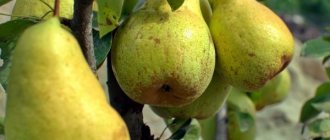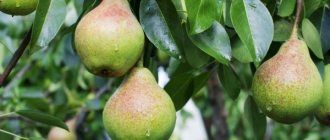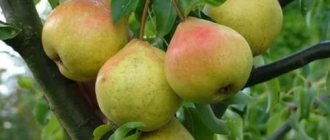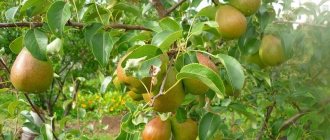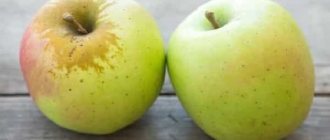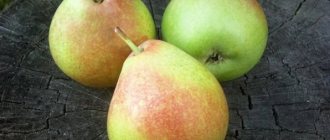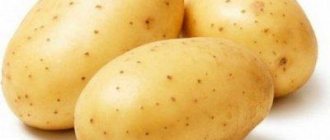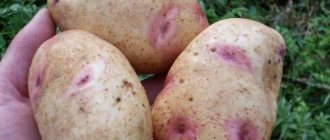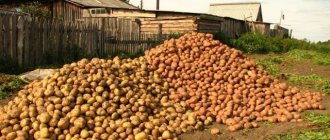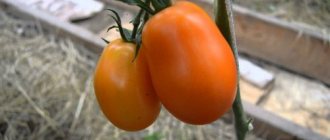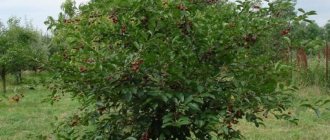The Fairytale pear was bred at the South Ural Research Institute by a team of scientists consisting of E.A. Falkenberg, M.A. Mazunin and V.I. Putyatin. The starting material for crossing was the autumn variety of pears with a long shelf life “Povislaya” and the frost-resistant high-yielding variety “Tenderness”.
Breeders tried to create a variety of pears (which are originally heat-loving trees) suitable for growing in Siberia with its difficult climate, and in such conditions giving a good harvest of tasty fruits. In 1993, the Fairytale Pear was accepted for State testing and zoned for the Ural, Central and Volga-Vyatka regions. By growing trees of the Skazochnaya pear variety, gardeners achieve excellent results both in the Krasnodar Territory and in the Moscow, Yaroslavl or Irkutsk regions, as well as in Ukraine, Belarus and Moldova.
To be fair, it should be noted that the Fairytale Pear is not the only variety that grows and bears fruit well in difficult climates; Moskvichka, Marble, Svetlyanka, Gera, and Krasulya pears have also proven themselves to be excellent. But in this article we will talk specifically about the summer variety of Fairytale pears, having examined in detail the characteristics of the tree and its fruits, and will discuss the intricacies of caring for the plant, its advantages and disadvantages.
History of selection
The Skazochnaya pear variety was bred by outstanding breeders - V. I. Putyatin, E. A. Falkenberg, M. A. Mazunin. To develop the variety, two varieties were crossed - the Povislaya pear (an autumn variety characterized by good keeping quality) and Tenderness (a winter-hardy variety that produces up to 40 kg of fruit from 1 tree).
The variety was bred in the organization FGBNU YUNIISK - a research organization that studies and creates new forms of agricultural plants. The institute began its work in the early 30s of the last century and to this day does not stop working on developing new varieties.
The fairy pear was bred specifically for the harsh climate of Siberia. The pear has become especially popular in the Urals. It is recommended to grow this variety in the Central and Volga-Vyatka regions. Gardeners in the Nizhny Novgorod, Krasnodar, Irkutsk, Moscow, Omsk, Yaroslavl, and Leningrad regions give preference to pears. The fairy pear is often found not only in Russia, but also in Ukraine, Belarus and Moldova.
You can find more information about pear varieties in the Moscow region here.
Description and characteristics of the “Fairytale” pear
The trees grow tall, reaching 4 meters. They are characterized by a narrow, dense, pyramidal crown and straight, spreading branches. The ends of the stems are directed towards the top of the plant. The trunk bark and skeletal stems have a brown tint, and slight peeling is also present. The shoots are even, smooth, without pubescence, and dark burgundy in color. The buds are small, curved, oval-round in shape, the surface is smooth. The leaves are small, elongated in shape with a pointed surface and uniform edges, emerald in color.
The fruits have a characteristic shape, are medium in size, reaching a weight of 180-200 g. Good care and rich feeding of the plant contributes to the production of larger fruits weighing up to 250 g. In high-yielding years, the fruits grow evenly, without defects. The peel is dry, dense, pale. When harvested, it has an emerald hue; when fully ripe, it becomes an amber-emerald color. There is a slight blush, the integumentary color is weakly expressed.
There are bright subcutaneous dots of a silvery hue. Pears have elongated, curved, wide stalks and a small, narrow funnel with minimal rustiness. The fruits have large, brown seeds that are shaped like a water lily. The snow-white pulp is oily, medium in density, fine-grained and juicy. The aroma is barely noticeable. The aftertaste is sweet and pleasant.
The tree begins to bloom in late May-early June. The variety attracts with its good early ripening. The harvest can ripen already 1-2 years after planting - about 3 kg of fruit can be collected from one plant. With age, the yield rate becomes higher. The tree enters full fruiting 4-5 years after planting, then gardeners collect up to 10 kg of fruit. After full ripening, the pears hold well on the stems and do not fall to the ground.
Description of the Lel pear variety
The Lel pear variety was originally intended for cultivation in the harsh conditions of Siberia and the Urals. But gradually he found fans in the Central and North-Western regions. Despite some shortcomings, it can often be seen in garden plots in Belarus and Ukraine. Gardeners appreciated the combination of winter hardiness, unpretentiousness, appetizing appearance of fruits and pleasant taste.
The Lel pear is medium-sized, with a mature tree height of about 4-6 m. The crown is compact. Long flexible shoots are curved upward and give it the shape of an ellipse. The variety is not prone to abundant formation of new branches and thickening of the crown, which makes pruning much easier.
The shoots of the Lel pear, judging by the description, are covered with dark red or burgundy bark. Young branches are smooth, only at the tips they have light grayish pubescence. At older ages they become slightly rough. The trunk and skeletal branches may take on a grayish tint.
The leaves of the Lel pear are small, oval, with finely serrated edges and a sharp outer nose. The leaf blades are smooth, without pubescence, and have a rich emerald color.
Interesting fact!
According to gardeners, the Lel pear blooms relatively late in Siberia and other regions. Lush white inflorescences are formed mainly on long and short twigs only in early June. Flowers and formed ovaries rarely suffer from return frosts.
The fruits are small, cone-shaped with a wide base, up to 4-5 cm. According to photos and descriptions of the Lel pear variety, during the fruiting period the tree is literally covered with clusters of fruits weighing 70-100 grams on stalks of medium and long length.
As can be seen in the photo of the Lel pear, during the period of technical maturity it is distinguished by a light green color. By the time they are fully ripe, the fruits acquire an amber hue, a light pink blush and a glossy shine. The skin of Lel pears is tender, of medium density, with a large number of greenish subcutaneous dots.
The seed chambers of pear fruits are closed, oval in shape and medium in size. The seeds are light. The flesh is creamy, buttery, juicy and soft. The taste is sweet and sour with a spicy but not tart aftertaste. The Lel variety belongs to the dessert variety.
Lel pear is unpretentious to grow. All it needs for development is a quiet place, protected from cold winds and drafts, an abundance of sunlight, and timely watering in dry years.
Pros and cons of the variety
The Fairytale pear variety has its advantages and disadvantages. The advantages include the following factors:
- Frost resistance. The variety can be grown even in the northern regions of Russia, where temperatures drop to -48 degrees.
- External features of the fruit. Ripe pears are attractive due to their regular and beautiful shape. The fruits are large, without any defects.
- High yield. From one tree you can get 10-15 kg of fruit. The plant's productivity increases every year. In addition, fruiting occurs already in the second year after planting.
- Drought resistance. The variety is able to withstand hot summers without losing yield.
- Early ripeness. The fruits ripen at the end of summer.
- Good fruit fixation. The pears hold tightly to the stem and do not fall off.
- Taste qualities. When ripe, the fruits acquire a sweet and spicy taste, become juicy and soft.
- Unpretentiousness. The variety takes root well on any type of soil and does not require special care.
We recommend reading this article, which will tell you about popular varieties of pears.
What disadvantages does the Fairytale pear variety have:
- The harvest is stored for no more than 10 days, then the fruits begin to deteriorate.
- The tree grows too high, which may cause difficulties in harvesting.
- Pears should not be transported - the fruits are easily damaged and therefore begin to quickly deteriorate and lose their external and taste qualities.
Planting and care
The Fairytale pear variety is propagated by different methods. The seed and vegetative methods are perfect . For seed propagation, seedlings are used as a rootstock. It is necessary to apply seed stratification. Planting takes place in the autumn.
It should be remembered that when propagating from seeds, the properties of the mother plants will not be preserved.
In the vegetative method, propagation by shoots and buds is used. This involves budding the variety onto the eyes of the tree. With this method, it is necessary to take into account the compatibility of varieties.
Where and when are pears planted?
Gardeners recommend choosing a suitable place where the area is level and there are no buildings. The variety loves good lighting. For planting, choose a place where there is no layer of clay at a depth of up to three meters. The site must have a low groundwater level.
If you plant a pear close to the house, in the future the roots of the tree can cause destruction of the foundation, which will lead to a deterioration in the strength of the building.
Purchased seedlings are planted in mid-autumn - around the end of September-beginning of October. This is due to the fact that the plant is dormant and will be protected from negative influences during the wintering period. It is allowed to plant a tree in the spring, but this must be done before the sap begins to flow. If you bought a seedling at any other time, it is better to plant it in a large pot and leave it for a while in a garage or shed where light penetrates.
Preparing the site
Although the variety is undemanding to soil fertility, to obtain maximum yield it is advisable to fertilize the area before planting. Gardeners claim that the Skazochnaya pear grows best on light soils devoid of humus. If you cannot fertilize the entire area, prepare the planting hole correctly.
Dig a hole for the seedling a month before planting - this is necessary so that the soil has time to settle. After this, mix the soil removed from the pit with humus and potassium-phosphorus fertilizers. Add lime or wood ash to soil that is too acidic.
Landing Features
Proper planting of a seedling does not end with preparing the substrate. To ensure that the tree takes root well, plant it in the ground carefully, without damaging the roots or weak shoots.
What requirements to adhere to when landing:
- Before lowering the seedling into the hole, rinse the roots with warm water and carefully inspect. If you see rotten or diseased roots, remove them. After this, shorten the excessively long roots so that the root system has a spherical shape. Treat the cut areas with activated carbon crumbs. If the roots are very dry, immerse the seedling in water for 24 hours - this will help soften it. If the situation is the same with the stem and leaves, immerse the entire plant in water.
- Inspect the shoots - if they are dry, cut them off.
- Land when the weather is calm and without wind. This way the plant will not freeze, and the roots will not begin to rot from a sudden excess of moisture.
- Dig a hole measuring 80x150 cm. Remove the bottom layer of soil, and leave the top layer with fertilizer to fill the planting hole.
- Before diving into the hole, spread the roots so that they occupy the entire area. You must do this so that the root collar is not covered by the substrate. When pouring soil into the hole, shake the seedling a little to remove “air pockets”.
- Cover the roots with the remains of fertile soil and compact them well.
- Drive a wooden stake near the tree at a distance of 25-30 cm.
- After planting, make a circle near the trunk and pour a lot of water into it, but to moisten the soil and not turn it into a swamp.
Features of growing crops
The best time to plant fruit trees is autumn. At this time, the seedlings are dormant, which is why they tolerate planting better. They also have time to take root and strengthen before spring, so from the beginning of April, energy will be spent on growth and development.
Important! You can plant a tree in the spring, but it is better to do it before the tree wakes up and lets out sap.
Planting the Fairy Tale pear is done in a specially selected and prepared place, since only in such an area will the plant bear fruit well.
When choosing a landing site, you need to consider:
- depth of groundwater;
- the depth of the clay layer (3 m or more).
- illumination of the area. The place should be on the sunny side. It is undesirable to choose a place for planting near which there are buildings, since the pear tree can damage the foundation.
You should choose a place with a flat area, away from buildings and other trees.
Before planting a seedling, it is advisable to enrich the soil. To do this, 3-4 weeks before planting, you should dig a hole, clean it of debris and roots and pour fertilizer into it. You should also reduce the acidity of the soil, for which you should also add wood ash. The depth of the hole must be at least 75 cm and the width - 1.4 m.
Important! You should not use fresh manure, only diluted and well rotted.
Before planting a seedling, you need to get rid of rotten and diseased roots and shoots. It is also recommended to cut off too long ones. Before the procedure, it is advisable to rinse the cut area with warm water. Trimmed roots need to be treated with crushed activated carbon.
Important! If the roots have dried out, then the seedling needs to be kept in water before planting. You can put the whole plant in it if the stem is also dry.
When burying the seedling, it is recommended to shake it a little to get rid of the void in the ground. After the seedling is installed in the hole and compacted, it is recommended to make a hole around it. This is necessary so that all the moisture reaches the lower roots and does not stagnate on the surface. At the end of planting, the tree should be watered (20 liters per seedling).
Caring for the Fairy Pear
The Fairy Tale Pear does not require scrupulous care, but if favorable conditions are created, you will receive rich harvests, and the tree will not suffer from diseases and pests. At the same time, care procedures will ensure a long life for the plant.
Watering
With abundant watering you will get juicy fruits. Therefore, water the tree regularly during flowering and fruiting. If the weather is very dry, moisten the plant daily by pouring water under the root. The amount of water depends not only on the age of the plant, but also on the type of soil and climatic conditions where it grows.
Do not use a sprayer for watering. If water constantly gets on the leaf plates, there is a possibility of burns, which can have a detrimental effect on the development of the plant.
Fertilizer
Even the most fertile soil is prone to losing its properties over time. If the tree's growth slows in the second or third year after planting, you will need to enrich the soil with ammonium nitrate. In addition, every autumn, when lightly loosening the soil, apply humus and mineral fertilizers in small quantities.
In the spring, feed pears of this variety with special fertilizers, which you can purchase at a specialty store. To maintain acidity, regularly add lime to the soil.
Trimming
Crown trimming is an important procedure that should be done correctly. The formation of the crown contributes not only to an attractive shape, but also to better growth and fruiting. Carry out the planned procedure in early spring, when the air temperature reaches 5 degrees:
- Remove branches that extend from the main trunk of the plant at a 90-degree angle.
- Cover the cut areas with clay - this will protect the tree from diseases.
- File at the bottom, then at the top of branches whose diameter is more than 3 cm.
- After the procedure, you can apply fertilizer 30 days later.
By autumn, the tree will definitely delight you with juicy fruits with a pear aroma.
Care
The fairy pear needs quality care. To obtain high yields, it is very important to carry out a number of timely agrotechnical measures:
- digging up the soil near the plant;
- weed removal;
- correct moderate watering;
- frost protection;
- constant feeding;
You also need to carry out sanitary pruning of the crown 2 times a year. During pruning, you need to remove dead or damaged branches. Those that do not bear fruit are also pruned. The cut areas must be treated with garden varnish.
Planting seedlings
When buying a seedling, you need to inspect it. Pay attention to the roots; under no circumstances purchase a seedling with signs of rot.
The tree should be planted so that the neck of the seedling is flush with the ground. Because this variety of pear does not tolerate deep planting depth.
After the work has been done, the plant needs to be watered and sprinkled with dry soil on top. A place for planting should be chosen that is not swampy. Excessive humidity can cause many diseases.
The plant needs to be watered periodically all summer after planting. Cover the tree with snow for the winter to protect it from rodents.
Top dressing
For good growth and development, the plant needs to be fed. When choosing fertilizers you need to consider:
- plant age;
- season;
- soil type;
- individual growth characteristics.
A fruit tree can be fed starting from planting a seedling. A little manure is placed in the hole mixed with soil. This helps strengthen the root system of the crop.
When digging a tree trunk circle near a tree, peat is added to the soil. Then the soil near the plant is watered so that the roots are saturated with useful substances.
The fairy pear needs quality care.
In spring, the tree is fertilized with nitrogen fertilizers. They bring great benefits during the growing season. Phosphorus and potassium fertilizers are also used with nitrogen fertilizers (in a ratio of 3:4:1).
More attention should be paid to fertilizing the crop in the 2nd year after planting. At this time, it requires a lot of nutrients, which are contained in fertilizers.
Diseases and pest control
The main advantage of this pear variety is its resistance to various diseases. The variety is resistant to scab, gall mite, black cancer, and fungal diseases. But due to improper care, the tree can be affected by the following diseases and pests:
| Disease/Pest | Symptoms | Control/Prevention |
| Sooty fungus | A disease that damages the leaves and fruits of pear trees. A black coating forms on them, similar in appearance to soot. Initially, weak trees and those lacking minerals suffer. The fungus is not afraid of severe frosts and hides under the bark of a tree. The main carriers are insects. | To prevent the disease, the insecticide Calypso is used. For treatment, treat the tree with Fitoferm fungicide. |
| Lightning or fruit rot | Brown growths appear on the fruits and their taste is lost. It is difficult to notice this disease because it appears during the ripening period. Damaged fruits dry out or fall off. | To prevent disease, in spring and autumn, treat the plant with a solution of lime in a ratio of 1:10. |
| Powdery mildew | When the disease occurs, a powdery white coating forms on the inflorescences and leaves of the tree, which later becomes the color of rust. Damaged parts begin to dry out and fall off. | To prevent disease, remove damaged leaves and burn. Also use folk remedies - spray the tree with a 1% potassium permanganate solution. |
| leaf roller | A caterpillar that gets inside the kidneys when they swell. The pest threatens by eating the buds, after which it feeds on the juice of the leaves. | To combat the pest, treat all trees in the garden with Karbofos, dissolving 30 g of the drug in 10 liters of water. Carry out the procedure until the buds open. |
| Shchitovka | This is a pest that causes dark cherry-colored bumps to appear on the branches and trunk of a tree - liquid leaks from them. The shoots dry out and die. | Destroy the scale insect. Whiten the tree with lime, combining it with copper sulfate - 1 kg 100 g. Treat with Tarstar or Clipper twice during the growing season. |
Pear "Kupava": description of the variety and photo
The Kupava pear has the following structural features:
- Tree. He is distinguished by average (in rare cases, slightly above average) height.
- Crown, branches. It has a predominantly round shape. The crown is most often quite dense.
- Escape. Generally straight growing, relatively thin, yellowish-brown in color. Fruit formations are presented mainly in the form of simple and complex ringlets - 3-5 centimeter branches ending in flowering or apical branches.
- Leaves. Very often, together with numerous branches, they form a highly thickened tree crown.
They are distinguished by their rounded shape and medium-sized plates.Usually smooth, dark green leaves are held on the branches with the help of rather long, thin petioles.
- Fruit. The size of the pears is average (sometimes below or above average). One fruit weighs on average from 85 to 100 g (under particularly favorable conditions, pears can gain weight up to 150 g).
For the most part, the fruits are distinctly lumpy, somewhat slanted, which does not add to their visual attractiveness. There is a sharp slope at the top of the fruit. The fruit is covered with a skin that is soft to the touch, has a characteristic shine and looks somewhat oily.The main color of the Kupava pear is golden yellow. Very often, a third of its total area is covered with a red blush. A few subcutaneous small green spots are barely visible on the surface of the fruit.
The asymmetrical pear is supported by a long, obliquely set stalk. The saturation of the juice of the dense white pulp is average. Inside the pulp, in closed seed chambers, there are round, brown seeds.
You can get acquainted with the variety in more detail and see the “Kupava” pears in the photo below:
Collection and storage of pears
The tree is harvested at the end of August, but if the weather is warm and there is no precipitation, there is no need to rush to harvest. Ripe pears do not spoil on the tree. Due to the fact that picked pears are stored for no more than 10-12 days, they are used to make juices, jams or compotes.
The fruits are harvested in warm weather; it is advisable to do this at one time in order to avoid crop losses. After picking, be sure to inspect the pears so as not to put “healthy” fruits with rotten, broken or damaged fruit.
When the fruits begin to deteriorate, their flesh becomes dark. When transporting, experienced gardeners recommend placing pears in one row, otherwise the fruits may choke. It is permissible to freeze fruits whole or crushed. This way the taste and vitamin composition of the fruit will be preserved. At a temperature of 2 degrees, fruit can be stored in the refrigerator for about 1 month.
Characteristics of the Svarog pear variety
When describing the Svarog pear variety, almost everyone who has encountered its cultivation notes its frost resistance. The root system and shoots are not afraid of frosts down to –30˚C. At lower temperatures, young shoots may freeze. However, this does not affect the overall yield.
Fruit trees tolerate a lack of moisture well, but they cannot be called drought-resistant. If there is no watering for a long time, pears lose their juiciness, the flesh becomes hard, and the peel becomes thick and rough.
Svarog pear belongs to the mid-season or what, they are also called early autumn species. Fruits for storage begin to be collected in mid-September. They reach full consumer maturity in the first half of October. Depending on weather conditions, dates may change. As a rule, pears have time to ripen on the branches before frost.
The Svarog variety is distinguished by high commercial qualities. Pears can easily be transported over long distances and have good shelf life. Pears collected at the stage of technical maturity can be stored in a refrigerator or cool room for 2-3 months. At the same time, they gradually ripen and retain their taste.
Svarog pears are universal in use. They are good fresh and suitable for making juices, compotes and jam. Small fruits are convenient to dry.
Interesting fact!
If the summer turned out to be dry, and the pears became tough due to lack of moisture, do not be upset. They make excellent candied fruit or jam with strong, candied pear slices.
Productivity
The Svarog pear begins to bear fruit 4-5 years after planting. The variety's yield is average, especially when compared with new species. On average, 19-21 kg of fruits are collected from a tree.
You can increase productivity by regular fertilizing and maintaining water balance. In addition, the best yield is shown by trees growing in well-lit places, but not in the sun itself.
"Pros and cons"
Among the descriptions of the characteristics of the Svarog pear as a variety, there are often conflicting reviews. Among the advantages are noted:
- high frost resistance;
- attractive appearance of fruits;
- high taste qualities;
- versatility in use;
- good shelf life and suitability for transportation;
- immunity to most diseases.
The disadvantages include:
- small fruits;
- loss of taste due to non-compliance with watering standards;
- some capriciousness of the variety to growing conditions.
Despite all its shortcomings, the Svarog pear variety deserves the attention of gardeners from regions with harsh climatic conditions, since fruit trees tolerate both cold winters and hot summers equally well.
Reviews about the variety Fairy Pear
Most gardeners speak positively about the variety, citing its resistance to diseases and pests.
★★★★★
Valery, 44 years old, gardener. During the entire time that I have three trees of this variety growing in my garden, they have not been affected by scab or gall mite.
But once my plants were affected by sooty fungus, but I managed to save the trees in time. The fruits I collect are large, juicy, and tasty. I like this variety because it is unpretentious. ★★★★★
Margarita, 34 years old, housewife. I planted a pear tree 4 years ago.
In general, I like everything about it, but there is also a drawback: it becomes difficult to harvest due to the fact that the tree grows tall. It is also not very convenient to transport fruits, because they are prone to damage. For commercial purposes, it’s not entirely good that pears don’t last long, but for myself it’s quite enough. ★★★★★
Konstantin, 32 years old, beginner gardener. I bought the Fairytale pear variety three years ago; the seller recommended it to me.
The fruits are very large, weighing up to 200 g. The peel is dense, but damaged very easily. The pears are juicy, tasty, and smell nice. I like to cut them into pieces and drizzle them with honey - a delicious treat. This dessert makes me happy every fall, and it also recharges me with healthy vitamins. Hide
Add your review
The Fairytale pear variety is the variety that most gardeners choose. Even with minimal care, the plant will bear fruit every year. And timely watering, regular fertilizing and pruning of branches will increase the yield several times.
0
0
Copy link
